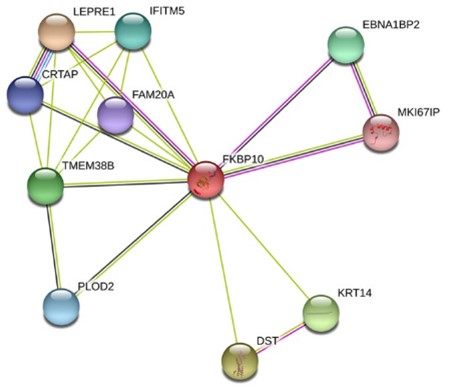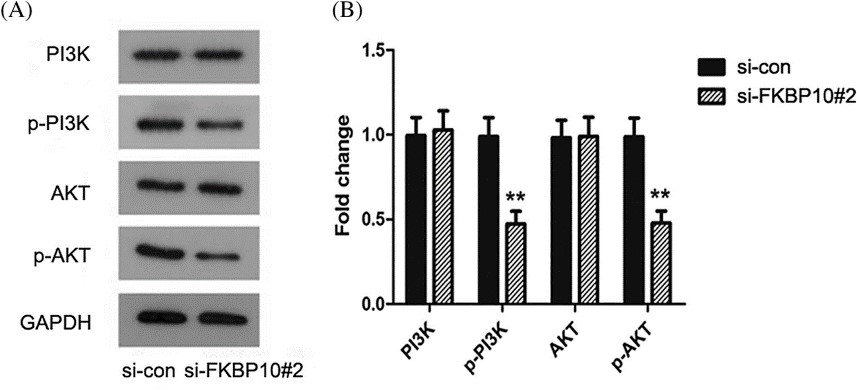FKBP10
-
Official Full Name
FK506 binding protein 10, 65 kDa -
Overview
The protein encoded by this gene belongs to the FKBP-type peptidyl-prolyl cis/trans isomerase (PPIase) family. This protein localizes to the endoplasmic reticulum and acts as a molecular chaperone. Alternatively spliced variants encoding different isoforms have been reported, but their biological validity has not been determined. -
Synonyms
FKBP10;FK506 binding protein 10, 65 kDa;FK506 binding protein 10 (65 kDa);peptidyl-prolyl cis-trans isomerase FKBP10;FKBP6;FLJ20683;FLJ22041;FLJ23833;hFKBP65;65 kDa FK506 binding protein;FK506 binding protein 10 65 kDa;FK506 binding protein 10;FKBP 10;FKBP 65;hFKBP 65;Immunophilin FKBP65;Peptidyl prolyl cis trans isomerase;PPIase;Rotamase;FKBP-10;FKBP-65;65 kDa FKBP;PPIase FKBP10;OTTHUMP00000164742;OTTHUMP00000164743;FK506-binding protein 10;65 kDa FK506-binding protein;OI6;FKBP65
Recombinant Proteins
- Human
- Mouse
- Rhesus macaque
- E.coli
- Mammalian Cells
- HEK293
- Wheat Germ
- In Vitro Cell Free System
- GST
- His
- Non
- Avi
- Fc
- DDK
- Myc
- Flag
Background
What is FKBP10 protein?
FKBP10 gene (FKBP prolyl isomerase 10) is a protein coding gene which situated on the long arm of chromosome 17 at locus 17q21. FKBP10, also known as FKBP Prolyl Isomerase 10, is a protein that in humans is encoded by the FKBP10 gene. It is a member of the FKBP (FK506 binding protein) family, which are immunophilins that act as peptidyl-prolyl isomerases. These proteins are involved in various cellular processes, including protein folding, trafficking, and signal transduction. FKBP10, specifically, has been associated with the regulation of extracellular matrix remodeling and has been implicated in the pathogenesis of fibrotic diseases, such as pulmonary fibrosis. Additionally, alterations in FKBP10 expression have been observed in various cancers, suggesting a role in tumor progression and metastasis. The FKBP10 protein is consisted of 582 amino acids and FKBP10 molecular weight is approximately 64.2 kDa.
What is the function of FKBP10 protein?
FKBP10 functions as a peptidyl proline cis-trans isomerase, involved in protein folding and processing. It is also involved in the regulation of extracellular matrix remodeling and may play a role in collagen maturation process. In hypertrophic scar formation, FKBP10 alleviates scar formation by inhibiting fibroblast activity and extracellular matrix deposition, suggesting that it plays a key role in scar formation and may be a target for the treatment of hypertrophic scar.

Fig1. Protein-protein interaction analysis of FKBP10. (Liang Liang, 2019)
FKBP10 Related Signaling Pathway
FKBP10 may promote the proliferation and metastasis of gastric cancer cells by regulating the epithelial-mesenchymal transformation process and TGF-β/SMAD signaling pathway. In hypertrophic scar formation, FKBP10 siRNA can inhibit fibroblast activity, reduce the expression of transforming growth factor-β1 and the activation of Smad signaling pathway, suggesting that FKBP10 plays a role in regulating the TGF-β/SMAD signaling pathway. FKBP10 may promote the proliferation of glioma by regulating the AKT-CREB-PCNA signaling pathway.
FKBP10 Related Diseases
The FKBP10 protein has been implicated in a variety of diseases, including neoplastic and non-neoplastic diseases. In terms of tumor, FKBP10 is associated with the development of gastric cancer, colorectal cancer, lung cancer and other cancers, and may promote the proliferation and metastasis of cancer cells by regulating epithelial-mesenchymal transformation (EMT) and TGF-β/SMAD signaling pathways. In addition, FKBP10 is also associated with bone diseases such as Bruch syndrome type 1 and osteogenesis imperfecta. In non-neoplastic diseases, the functional study of FKBP10 contributes to the in-depth understanding of its role in the occurrence and development of diseases, and provides a new molecular target for the diagnosis and treatment of related diseases.
Bioapplications of FKBP10
FKBP10 protein has important applications in medical research and drug development. FKBP10 may serve as a biomarker in studies of tumor development, particularly in stomach, colorectal, and lung cancers. In addition, in the field of drug development, the interaction properties of FKBP10 make it an important target for screening anti-tumor drugs to achieve anti-tumor effects by inhibiting the function of proteins that interact with it. The expression level of FKBP10 can also be used as a biomarker for tumor diagnosis and prognosis assessment, as well as an indicator for monitoring drug therapy response.
Case Study
Case Study 1: Giorgio Ramadori, 2020
Cancer therapy is limited, in part, by lack of specificity. Thus, identifying molecules that are selectively expressed by, and relevant for, cancer cells is of paramount medical importance. Here, researchers show that peptidyl-prolyl-cis-trans-isomerase (PPIase) FK506-binding protein 10 (FKBP10)-positive cells are present in cancer lesions but absent in the healthy parenchyma of human lung. FKBP10 expression negatively correlates with survival of lung cancer patients, and its downregulation causes a dramatic diminution of lung tumor burden in mice. Mechanistically, the results from gain- and loss-of-function assays show that FKBP10 boosts cancer growth and stemness via its PPIase activity. Also, FKBP10 interacts with ribosomes, and its downregulation leads to reduction of translation elongation at the beginning of open reading frames (ORFs), particularly upon insertion of proline residues.

Fig1. Data were obtained from KMPLOT (high and low values of expression were split by median expression of FKBP10).

Fig2. Western blot for the levels of FKBP10 and the ribosomal S6 protein.
Case Study 2: Ruo-Gu Wang, 2020
As documented, the expression, biological roles, and prognostic significance of FKBP10 in stomach adenocarcinoma (STAD) have not been investigated till now. This drives to detect the biological roles and clinical significance of FKBP10 in STAD. The expression level of FKBP10 was measured based on the data obtained from the TCGA, ONCOMINE, and GEPIA databases, and STAD cell lines. Through in vitro experiments, cell behaviors were investigated to evaluate the effects of FKBP10 on STAD. Moreover, the PI3K-AKT signaling pathway was measured. The results showed that FKBP10 might serve as a crucial player in gastric cancer, and targeting FKBP10 might provide clinical utility in gastric cancer in future.

Fig3. High expression of FKBP10 is connected with a poor overall survival in STAD patients.

Fig4. Western blotting was used to determine the expression levels of PI3K, p-PI3K, AKT, and p-AKT in AGS cells after FKBP10 knockdown.
Quality Guarantee
High Purity
.jpg)
Fig1. SDS-PAGE (FKBP10-1289H)
.
.jpg)
Fig2. SDS-PAGE (FKBP10-58H)
Involved Pathway
FKBP10 involved in several pathways and played different roles in them. We selected most pathways FKBP10 participated on our site, such as , which may be useful for your reference. Also, other proteins which involved in the same pathway with FKBP10 were listed below. Creative BioMart supplied nearly all the proteins listed, you can search them on our site.
| Pathway Name | Pathway Related Protein |
|---|
Protein Function
FKBP10 has several biochemical functions, for example, FK506 binding,calcium ion binding,peptidyl-prolyl cis-trans isomerase activity. Some of the functions are cooperated with other proteins, some of the functions could acted by FKBP10 itself. We selected most functions FKBP10 had, and list some proteins which have the same functions with FKBP10. You can find most of the proteins on our site.
| Function | Related Protein |
|---|---|
| FK506 binding | FKBP5,FKBP1AA,FKBP1B,FKBP4,FKBP8,FKBP9,TTC9B,NFATC1,TTC9C,FKBP6 |
| peptidyl-prolyl cis-trans isomerase activity | PPIF,FKBP4,PPP2R4,FKBP11,FKBP10B,PPIAB,PPIC,PPIL4,PPIFB,PPIFA |
| calcium ion binding | MYL9B,MMP8,KIAA0494,CANX,CALM1,SULF2A,SLC24A2,CALR,CGREF1,CCBE1 |
Interacting Protein
FKBP10 has direct interactions with proteins and molecules. Those interactions were detected by several methods such as yeast two hybrid, co-IP, pull-down and so on. We selected proteins and molecules interacted with FKBP10 here. Most of them are supplied by our site. Hope this information will be useful for your research of FKBP10.
cona_canen;H2AFX;SLX1A
Resources
Related Services
Related Products
References


